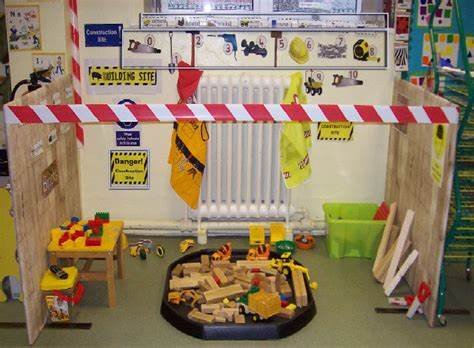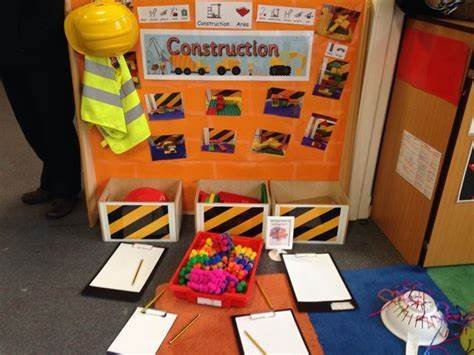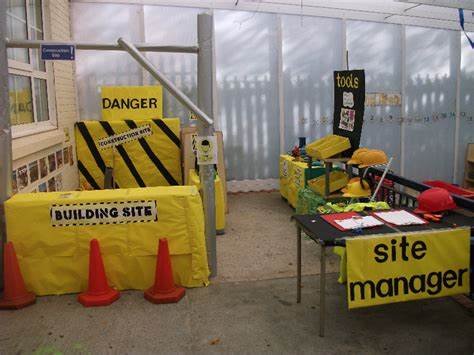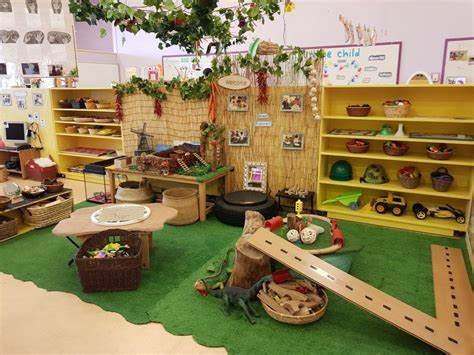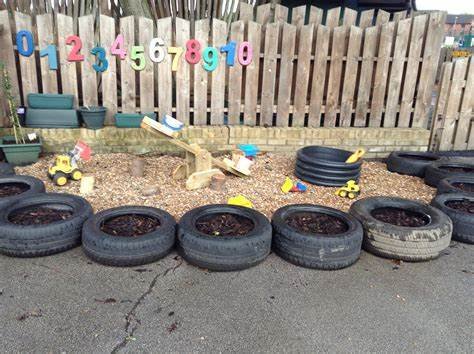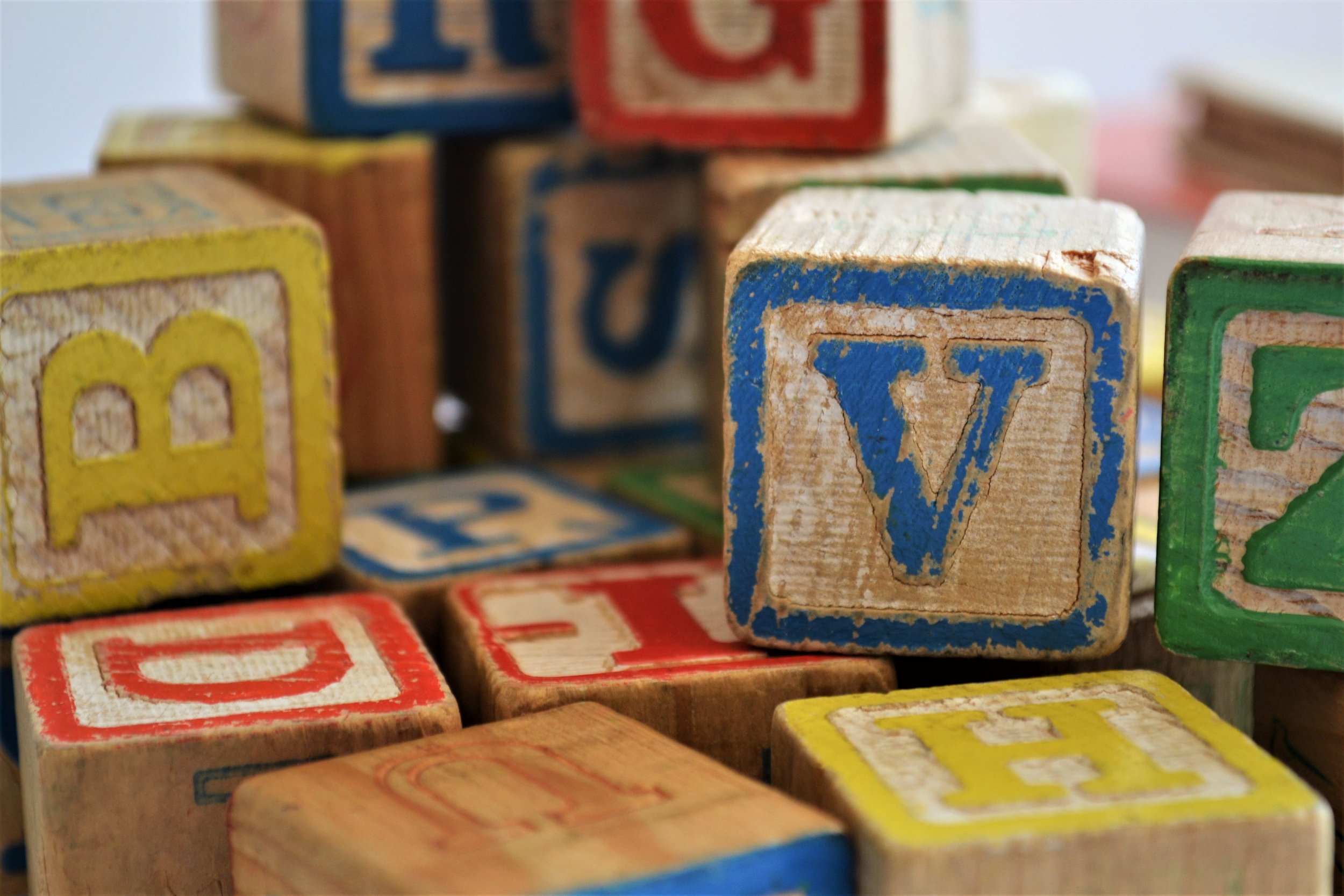Supporting Storytelling Through Block Play in the Early Years
Children will go through different stages as they begin to use props to make up stories and add dialogue to their play…
For our final blog post in our block play series, we are going to look at how block play can support children to develop that inner storyteller. Whether that be through incorporating small-world play and props role-playing being construction workers. There is lots of opportunities and ways that we can support children to develop their narrative, communication and language skills, and personal social and emotional skills as they work together to add a storyline to their play.
What are the stages of story telling in play?
Children will go through different stages as they begin to use props to make up stories and add dialogue to their play. For example, children may begin to add voice sounds as the run a car across the floor going “brrm brrm”. This is the very early stage of children adding dialogue to represent their understanding and experiences. We then act out our familiar experiences using available props, for example, we may pick up the hammer and begin to bang the hammer and represent what they have observed others doing. As children get older, they begin to play alongside other children in their play, so for example, we all might be playing tea shops making teas and coffees. We are engaged in the same activity, but we are not necessarily reliant on each other for our play or interacting with one another. Children them move into the stage of collaborative play where they are working together to develop their storyline and direction of play.
The reason I share the stages of play is that it is important to reflect on where your individual children are in their journey when you are supporting storytelling through play. For example, if you have a child who is many solitary in their play but is beginning to add noises and sounds to their play. You maybe supporting them by modelling joining in and playing alongside others. Or using communication and language to invite them in and add narrative to a play and to show them perhaps (not an indefinite way as play is open ended) but suggestions that could spark their interest or enhance their play. For example, you build a bridge using the construction blocks. You test to see if it is high enough to fit the toy car underneath. You then might add some “brrm brrm” or “beep beep” noises as you move the cars around.
Ways to support storytelling in block play?
There are many ways that we can support story telling in block play, through providing children with a range of rich and wonderful experiences and resources. Below are some ideas to support children:
Have a range of fiction and non-fiction books around building and builder’s sites. This will give children knowledge and understanding that they can add into their story telling.
Have a local builder come in and talk about their job or visit a local builder’s site to see what happens.
Model to the children play and developing stories around available resources. For example, children might need to see an adult model how we use a spirit leveller to know how we use it.
Add in small-world props and resources based on children’s interests – e.g. cars, toy people, animals, dinosaurs and so on.
Provide story sacks or baskets with available resources to retell those familiar stories. For example, the 3 Billy Goats Gruff Book and puppets; with the building blocks. This may inspire the children to build their own bridge for the big bad troll to be hiding under and to retell the story. This can either be left as a provocation to see what the children do with it or it can be an adult directed activity where you work together to build the bridge and scaffold the children as they work and retell the story altogether.
Add dressing up items such as hard hats and high visibility jackets, to encourage them to role-play being builders.
Have real resources such as tape measures, rulers, spirit levellers and so on to support children to act out those experiences using the props around them.
Encourage children to share with others and talk about what they have built and describe it.
Join us for our next running of our webinar, ‘The Potential of Block Play in the Early Years’ on the 1st September 2022 at 7:30 pm
Block Play and Mathematical Development in the Early Years
A classic early year’s example, often children explore building towers often setting the challenge to see who can build a tower taller than themselves. This instantly lends itself to some discussions about size…
Welcome to our next series in our block play series. This week we are going to be focusing on how block play can support children developing their mathematical skills through construction play. Mathematics is literally all around us and when children are playing and engaging, there is always potential for lots of opportunities to develop across all areas of the curriculum. Hands on experiences give children opportunities to learn about mathematics in a variety of contexts.
To find out more about mathematics being all around us why not check out our webinar recording ‘Mathematical All Around Us’.
Measuring in Block Play
Children use play to replicate their experiences and things that they observe others doing. This is an important way that children make connection and sense of the world around them. The introduction of resources such as tape measures and rulers can support children as they look at measuring their buildings and constructions. As they make comparisons about size, height and length of their buildings and constructions.
(Photo Credit: Pinterest)
Often this replication although supporting children’s ability to add narrative to their play and storylines alongside others (remember before children can write a story, they need to be able to tell stories with others!). But it can be limited by children’s mathematical skills, as to use a ruler or tape measure they often must understand and know large numbers to interact with this mathematical concept. Consider introducing resources that children can use that are non-standard units such as a set of handprints, multilink, footprints or Duplo. This means the children will be able to count the objects and incorporate mathematics into their play without adult support with large numbers.
Children will also problem solve, measure, and make comparisons of size and use a rich array of mathematical vocabulary such as bigger, smaller, tiny, longer, little, huge, shorter, and so on without the introduction of standard and non-standard units. As they join in conversations, they talk about their building and make comparisons. While they participate collaboratively to develop ideas. To stretch their understanding and their limits.
(Photo Credit: Project Matters)
A classic early year’s example, often children explore building towers often setting the challenge to see who can build a tower taller than themselves. This instantly lends itself to some discussions about size, as children may begin to make remarks such as “It is smaller than me!” Or “it is bigger than me!” This is a great opportunity for us as early years practitioners to extend learning in the moment. For example, introducing new language such as height, width, length and modelling a vast array of mathematical language. As we build and play alongside the children and build towers and make comparisons. There is also the opportunity to make comparisons between towers, for example, “How many blocks taller than you is your tower?”
Symmetry in Block Play
As children progress through the stages of block play in stage five (patterns and symmetry) they begin to make symmetrical buildings. This means that they are beginning to develop a basic understanding of symmetry and looking closely at patterns and similarities in buildings. They will also be developing an understanding of shapes and numbers as they explore making sure that they put the same shape and number of blocks in either side of the invisible line. For example, I need to red blocks, and one large brown cylinder and one large orange cylinder for either side. We may even begin to show a practical understanding of doubles or putting numbers together and learning simple number bonds.
Exploring Symmetry
When thinking about children who are beginning to explore symmetry and patterns in their block play. You might want to consider:
Do you have different coloured and shaped blocks?
Can you introduce mirrors to play and photos?
Can you bring in art activities that explore patterns and symmetry?
Making Buildings
Some children will be in the stage of block play when they are beginning to make representation of buildings. This is a great time to be incorporating house photos, and photos of different types of buildings where children can start to explore and talk about the natural patterns and symmetry in buildings. Additionally, think about adding clipboards and pens to promote early mark-making where children can design their own buildings.
Building designs can easily bring in mathematical concepts and vocabulary for example, sharing size of bricks, how many? Or does your building have windows? Whether that is part of a discussion or shared mark-making or individual mark-making with a skilled practitioner. You can easily build in children’s mathematical vocabulary and skills as they design and create their very own buildings.
If you would like to join our webinar, ‘The Potential of Block Play in the Early Years’ please click below to find out more or purchase your ticket now.
Physical Development and Block Play
Construction play is a firm staple of many early year’s settings, whether that be through Duplo, wooden blocks, Lego, large blocks, or community play blocks and everything else in between. We use a wide array of items to support children’s learning and development…
Blog Post One in Our Block Play Series
Construction play is a firm staple of many early year’s settings, whether that be through Duplo, wooden blocks, Lego, large blocks, or community play blocks and everything else in between. We use a wide array of items to support children’s learning and development. Join us for our new series that will look at block play in early years settings. This first blog is going to look at how block play can support children’s physical development.
Many years ago, I was in a meeting with an Occupational Therapist (OT), and she shared with us, how much she loved the fact we used Lego in the preschool. She sat there and said, “Lego is just amazing, and is exactly what Child A needs to support his physical development!” This made me smile so much, because it is so true and often, we can forget the value of the everyday toys or equipment we use and how they support children’s learning and development.
I guess in the very simplistic term, we can forget the why we purchased those resources in the first place. Or perhaps they just form part or our continuous provision and environment because it is just ingrained and that is how it has always been. At the moment in the early years, it is very refreshing that we are really unpacking our practise, pedagogy, curriculum and enabling environments. We are thinking about the why or intent behind everything that we are doing, and the implementation (how we are doing it) and the impact (the difference it makes to children’s learning, development and well-being.
Do you want to explore the topic of intent, implementation and impact more? Why not join out webinar, ‘Exploring the 3I’s: Intent Implementation and Impact’?
So, let’s go back to the Lego and think about some of the physical skills that children are developing when they are building with construction toys such as Lego, Mega Blocks or Duplo that connect:
· They are developing the strength and muscles in their fingers, hands, and arms as they push the items together and pull bricks apart.
· Developing fine motor skills.
· Developing their hand-eye coordination.
· Developing wrist, elbow and shoulder pivots.
· Developing spatial awareness.
· Developing bilateral coordination (this is having control over both sides of the bodies, to coordinate movement and the development of both sides of the brain talking to one another).
This is true for lots of block play activities, children are learning to balance, control over small muscles and movements, spatial awareness so that they do not knock their towers down and bilateral coordination. We also know that when children are exploring building with big blocks, we are also supporting those larger gross motor skills and coordination as children move and negotiate space as they build. Quite simply there are many benefits to children’s physical development by participating in block play.
Keep your eyes peeled for our next blog post in our series that will look at how block play can be enhanced to incorporate early literacy development.
Do you want to explore the potential of block play more? Why not join our webinar, The Potential of Block Play in Your Continuous Provision?



